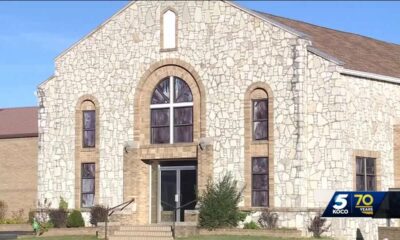News from the South - North Carolina News Feed
Why won’t Duke Energy just bury the lines? And other power restoration questions. Any looting in downtown Asheville? Why is the landfill still charging residents for storm debris? • Asheville Watchdog
Today’s batch of Helene questions and answers includes the motherlode of Duke Energy questions. Duke spokesperson Bill Norton answered these all in a flurry late last week, so I’m getting all five of them all out the door today, along with one question regarding reports of looting and another about the Buncombe County landfill.
Let’s get to the questions, a few smart-aleck yet tasteful responses, and the real answers:
Question: Without getting down to each nut and bolt that needs to be replaced, what specifically is preventing the power from being restored? Too many transmission lines down? What substations need to be completely rebuilt? Is this a manpower or money issue?
My answer: I remain incredulous that the human species survived — even thrived — for thousands of years without electricity. What a barbaric life that must have been.
Real answer: Norton noted that as of Friday Duke Energy had restored nearly 1.5 million customer outages in North Carolina from Hurricane Helene.
Norton said that as of 3:45 p.m. on Monday, Duke had 8,590 outages remaining, with 5,283 in Buncombe. At 10 a.m. on Monday, the numbers stood at 9,830 customers without power, with 6,684 in Buncombe County.
While numbers usually trend downward, Duke is seeing occasional upticks.
“We’re going to continue having some see-sawing like this as trees that are weakened but still standing come down when winds blow through,” Norton said. “Our vegetation crews are still working that ongoing challenge.”
To give you an idea of the progress Duke and the emergency crews from all over the country made here, as of noon Friday outages totaled 32,000 in the mountains, down from 49,000 the day before.
Now, about the difficulty inherent in these restoration efforts.
“Many areas of Western North Carolina were unreachable due to mudslides, flooding and blocked roads, limiting our ability to assess damage and make repairs, so we have also deployed drones and helicopters to assess and help with power restoration in inaccessible areas,” Norton said.
Norton said federal and state agencies, as well as local emergency responders, “have been invaluable in assisting with road access and other needs so our crews could get to work.”
“To highlight one example, NCDOT was able to build a temporary solution for a washed-out bridge in Haywood County, where power restoration is now complete,” Norton said, noting the outage map on Monday showed a single Haywood customer without power, a new outage first reported Monday.
Of course, the goal is to get the power back on to all remaining customers with outages. But it’s a huge job.
“Some will be restored within the coming days,” Norton said. “Other properties remain inaccessible or are not able to receive power — for reasons such as structural damage — and will be without electricity for an extended period of time. It’s going to take collaboration with local, state and federal agencies to get the job done, but we will not stop until everyone’s power is restored.”

Question 2: How much damage did the power grid sustain in Buncombe County? The rest of western North Carolina? By that, are major substations down? Or are we talking mostly just a lot of power lines down?
Answer: “The devastation of Hurricane Helene was unlike anything we have seen before in our history,” Norton said. “We experienced significant transmission, substation and power line damage, particularly in western North Carolina and Upstate South Carolina.”
Norton noted that Interstate highways were knocked out by Helene.
“Duke Energy’s version of the interstate, our transmission infrastructure, experienced significant damage too,” he said. “We focused on restoring this critical infrastructure first, along with essential facilities — emergency service and vital facilities such as Mission Hospital and the VA hospital in Asheville, law enforcement, fire departments and water treatment facilities.”
As an example, Norton noted that the transmission and distribution lines supporting the Town of Marion water treatment plant (in McDowell County) were washed away.
“The devastation was so severe that our crews working in the area couldn’t even find the poles,” Norton said. “Our crews worked night and day to rebuild the infrastructure and restore power to the water treatment plant by Oct. 3.”
Duke also brought in three mobile substations to replace flooded substations.
“That allowed us to restore power to the thousands of customers served by each, even as the substations must be fully rebuilt in the months ahead,” Norton said. “Overall, hundreds of substations were damaged — all were restored by Oct. 4 with the exception of the final two mobile substations, which came online on Oct. 7.”

Question 3: Why doesn’t Duke Energy just bury the power lines once and for all? I know it would be expensive, but wouldn’t that be better than lines going down during every major storm? How much does it cost to bury power lines?
Answer: First, Norton said that burying power lines “would not have prevented the catastrophic damage presented by Helene.”
“Every underground line is connected to an above-ground line somewhere, such as transmission lines and substations that cannot be buried and which were significantly damaged during this historic storm,” Norton said. “We often build underground lines in new construction, but it is not feasible to retroactively underground the majority of existing lines.”
About 20 years ago, the North Carolina Utilities Commission requested a study on what it would cost to run lines underground.
“Based on the results of its investigation, the NCUC public staff concluded that it was not feasible to replace the existing overhead distribution power lines with underground power lines,” Norton said. “Such an undertaking would have cost approximately $41 billion and would take a workforce of nearly 5,000 employees 25 years to complete the project — keep in mind that was in 2003 dollars, and prior to the major population growth experienced by North Carolina.”
As you might have suspected, our mountains pose another challenge.
“Looking at the mountains specifically, undergrounding lines through the significant rock in this area costs about 10 times as much as elsewhere in the state, and undergrounding would also require massive tree removal to bury lines where tree roots are today,” Norton said. “For all those reasons and more, it’s not a feasible solution.”

Question 4: On Monday, Sept. 30, I drove by the Asheville Outlets mall. There, and in adjacent business lots, I saw dozens of powerline service trucks and trucks for tree services sitting idly. In several cases, affiliated workers were standing around. Given the immensity of the need in the area, I’m curious about this. I live in the Kenilworth area, and several major roads were still blocked, many large trees were down, with power lines scattered around. And of course, we still do not have electricity (power was restored to Kenilworth this past weekend). I understand the importance of a triaged approach to all of this, but I wonder why it is not possible to utilize resources that are here, ready and waiting.
Answer: “Immediately after a storm blows through, damage assessment is the first step so we can determine exactly what type of crews, equipment and materials are needed before we deploy crews to a specific site,” Norton said. “This helps us efficiently identify the right types of crews (line, tree, etc.) and have the right materials and equipment to get to work on repairs. You’ll often see line crews getting organized at staging areas while this initial assessment is being undertaken by damage assessors.”
Norton pointed out that the damage assessors, vegetation crews, and line workers have been “working 16-hour days for two solid weeks to get customer power on, typically leaving these staging areas before dawn and returning after sunset.”
“During the initial phase of the storm when communication networks were down, line trucks had to return to base operations more often than you’d see in a typical storm to get new assignments and map out routes by hand since GPS wasn’t working,” Norton said. “Additionally, crews do need to rest and refuel — both for themselves and their equipment. Working with electricity is hazardous work, and keeping line workers rested and alert is vital for safe power restoration.”
On a personal note, I’d like to thank these line crews for coming in from all over the country and busting their rear ends to restore power. It’s been an amazing effort.

Question 5: We’re a homeowners association of Cedar View and Ridge View just off Lovers Loop, and we seem to have fallen off Duke’s maps for repairs. Our 29 houses remain dark while those around us have power. Duke’s power outage maps are incorrect. A number of us have been calling and getting nowhere. Colder weather is forecast in the coming days. We’ve been working hard clearing the roads but nothing from Duke. I wonder if you can get Duke’s attention.
Answer: Consider it gotten.
“When repairs are made to a large outage affecting thousands of customers, that repair is considered ‘complete’ in our system, which automatically triggers an alert to all affected customers,” Norton said. “There may, however, still be a smaller problem that requires repair before power can be restored to your home.”
If you get a “repairs completed” text and your power is still out, Norton said to simply reply “OFF” to let Duke know your power is still out.
“This will help us isolate the piece of equipment still in need of repair and get your power restored,” Norton said.

Question: I love my friend dearly, and normally this friend is a reliable source of information. But this person owns a store in downtown Asheville, and she has received reports of looting by “vagrants” of closed stores in Asheville. Please confirm or refute this information. It is not my friend’s personal knowledge. It is a report from an employee. I have suggested she call the police or Chamber of Commerce to verify the report, but I don’t believe she will. This is the kind of news that can spread quickly as misinformation, and I hate this could be true.
My answer: Well, at least no one has tried to politicize this immense human tragedy for political gain.
Real answer: “After reviewing our records, and discussing with leadership, there have not been reports of looting by ‘vagrants,’ as you put it,” Asheville Police Department spokesperson Rick Rice said via email. “There have been some reports of larceny and of breaking and entering, but no more than occurs under normal circumstances.”
I’d like to note that “vagrants” was not my word. Just covering my rear end here.
“There are no reports in our system of looting downtown that I can find, but if your friend or anyone knows of it occurring, we would encourage them to contact the APD and file a report so it can be investigated,” Rice said.
I’ll also note this question came from a reader I do not personally know.
Other parts of town did see some looting, Rice noted.
“There were some instances of looting in the immediate aftermath of the storm, but those occurred at box stores and other retail outlets located outside downtown,” Rice said. “There were two instances where arrests were made while a theft was being attempted, and we issued press releases on both.”

Question: My house has been pretty much destroyed, as have so many others. We have sent five truckloads of debris to The Buncombe County Landfill. Can you please tell me why they haven’t waived their fees during this tragedy? Every time we go, I get madder and madder at this seemingly small thing. However it totally upsets me that they are not working with us.
My answer: I shall offer no sarcasm here, as this has got to be incredibly frustrating under the circumstances.
Real answer: Buncombe County spokesperson Kassi Day said this situation gets a little complicated.
“While we have temporarily waived residential bagged trash fees at the transfer station, we cannot afford to waive commercial tipping fees for construction waste and other debris,” Day said via email. “Solid Waste is an ‘enterprise’ fund, which means it is supported by fees and is not intended to be subsidized by tax revenue. FEMA will not reimburse the county for waived tipping fees.”
Day said the county is collecting debris from “critical infrastructure, such as hospitals, schools, and water facilities.”
“We are still assessing the total volume of debris before we start a broader collection effort,” Day said. “Once we know the scope, we will begin to clear all public roadways. Then the county will begin collecting residential debris that people have placed in the right-of-way along public roads.”
Day said people can start placing debris there now, with an important addendum.
“This is important: It will speed up collection for all of us if everyone separates their debris by type,” Day said. “Appliances, construction materials, electronics, and hazardous household materials (herbicides, paint, small propane tanks, solvents) should be placed into separate piles.”
Day said the county has contracted with a removal company to provide the collection. The county hopes to have more information to share with the public this week, she added.
Asheville Watchdog is a nonprofit news team producing stories that matter to Asheville and Buncombe County. John Boyle has been covering Asheville and surrounding communities since the 20th century. You can reach him at (828) 337-0941, or via email at jboyle@avlwatchdog.org. To show your support for this vital public service go to avlwatchdog.org/support-our-publication/.
Related
The post Why won’t Duke Energy just bury the lines? And other power restoration questions. Any looting in downtown Asheville? Why is the landfill still charging residents for storm debris? • Asheville Watchdog appeared first on avlwatchdog.org
News from the South - North Carolina News Feed
Why did Biltmore remove the beautiful old trees at its main gate? Lead flushing necessary at apartment buildings? City water has a ‘swampy’ smell to it? • Asheville Watchdog
Today’s round of questions, my smart-aleck replies and the real answers:
Question: Why did the Biltmore Estate remove all of those beautiful trees at the entrance gate?
My answer: It’s all part of Biltmore Village’s new holiday marketing program, “It’s beginning to look a lot like a hurricane hit us.” It’s probably not the best marketing program in the world…
Real answer: Chalk this up to yet another notch in Tropical Storm Helene’s belt of destruction.
As most folks are aware, floodwaters rose to historic levels in Biltmore Village, including at the estate’s iconic entrance gate. The watermark on the gatehouse building remains visible, about two-thirds up the first floor of the two-story structure.
The trees lining the road leading to the gate were indeed iconic, as they’d been with us for more than a century.
“The tulip poplars that once lined the entrance to Biltmore, many of which were over 100 years old and original to the estate, suffered significant damage when the flooding caused by Tropical Storm Helene washed away the soil around their roots,” Biltmore Estate spokesperson Marissa Jamison said via email. “In addition to root damage, several trees experienced trunk damage, and a few were left leaning after the storm. As a result, the difficult decision was made to remove the trees.”

The rows of poplars were planted during estate builder George Vanderbilt’s time, and they once stretched all the way to the depot in Biltmore Village, Jamison noted. Bill Quade, director of horticulture at the estate, shared that before Helene, 17 tulip poplars lined Biltmore’s entrance, 13 of which were original to the estate.

“In the spring, we plan to replant these majestic trees as part of a broader effort to rebuild Biltmore’s entrance that we are working on following the losses we’ve all endured,” Jamison said.
The Gate House Gift Shop near the entrance also sustained heavy damage, and Jamison said the future of that building “is still being assessed.”
The 250-room home and 8,000-acre estate, which Vanderbilt originally opened in 1895, had to shut down after Helene downed trees and caused flooding Sept. 27. It reopened Nov. 2 and is hosting many of its popular seasonal programs, including Candlelight Christmas Evenings.

Question: With the concern about lead in the city water, can you ask about apartment buildings and flushing? How are they flushed? I live in the Kenilworth Inn building and it was built around 1910. How does flushing work in an old apartment building? Any other tips to avoid lead in the water? Apartments, to my knowledge, have never been mentioned at the daily briefings, but I easily could have missed it.
My answer: I remember the good old days when “flushing” was just something you had to remind your kids to do after they did their business. I miss those days.
Real answer: As we’ve previously reported, the city announced Nov. 14 that it had found detectable levels of lead in seven schools. The Water Resources Department has stressed that this occurred when the schools were closed and the water sat in pipes, which can lead to lead leaching into the system.
Also, the city suspended its anti-corrosion treatment program for 19 days because of high turbidity in the North Fork Reservoir. In older pipes where lead solder was used, corrosion from chlorine and other chemicals can cause the lead to leach into the system.
The anti-corrosion program was reinstated Oct. 30, but it can take more than a month to become effective again.
The city announced Nov. 18 that the water it was producing was potable again. Until that point, the city had recommended bottled water for any consumption, although it did say if no other sources were available, customers could consume water boiled for at least one minute.
The city has stressed that no lead is in its distribution pipes, but lead can be found in pipes of buildings and homes built in or before 1988, when lead was banned. It also has emphasized that if you flush pipes for 30 seconds to two minutes before using, that removes the lead.
I asked specifically about apartment buildings at the Thursday daily Helene briefing, and Brenna Cook, the compliance manager for Asheville Water Resources Department, said they should not be of any more concern than older homes.
“So in apartment buildings, people are pretty much using water all the time, but it probably would be good for those property managers to do a system-wide flush,” Cook said. “A lot of those apartment buildings are master metered, so they would want to flush their lines themselves and then direct their tenants to flush their water as well.”
Water usage varies among tenants, Cook said, and the city doesn’t have any way of tracking that individually.
“If the tenant cannot get their building property manager to flush, we do still suggest flushing their water for 10 to 15 minutes at first, but then follow that with 30 seconds to two minutes each time they use the water for consumption, if it hasn’t been used for more than four hours,” Cook said.

Question: (I’m combining two reader questions here) 1. Are there other possible contaminants in the North Fork Reservoir that are not being tested for? 2. OMG, the water is putrid. I chanced a shower and a shave, and washed my hair. I’ve carried a sickening smell all day. Is this our new reality? I lived in Tampa for 25 years, and they got their water from the god-awful Green Swamp. The city water smells like Tampa water.
My answer: I imagine this made you a popular figure at the hot yoga studio.
Real answer: As far as contaminants in the North Fork Reservoir, the city has noted previously that because the reservoir is outside of Black Mountain and in a 20,000-acre watershed that is almost completely undeveloped, the water coming into it from the flooding did not contain chemicals or other materials associated with industry, businesses or other development.
On Thursday, Cook said they continue to test the raw water at North Fork, with results posted on the city’s Water Resources page.
“All the detections came back as normal,” Cook said. “You have to remember, North Fork is a protected watershed, so there’s less likelihood of stuff like that happening during a rain event. I’m not saying we didn’t have a lot of turbidity washing in, but there’s less worry of something like that occurring In the North Fork watershed.”
Assistant City Manager Ben Woody said at the briefing that if you do have discolored water, your first step should be to call the Water Resources customer service line at 828-251-1122.
“But the other thing to remember is, we still operate a significant and substantial water system, just like we have in the past,” Woody said. “We still have breaks that we have to repair.”
The city has had several breaks since repressurizing the system in mid-October.
“We do go repair those, but oftentimes, under normal business, if there’s a water main break there may be for a certain area a boil water advisory,” Woody said. “There may be some discoloration of water.”
Neither Cook nor Woody commented on any “swamp smell” coming from the water. I’ll note that I’ve not heard that complaint from other readers, at least not yet.
Woody stressed that the water going into taps has a very low turbidity — .1 Nephelometric Turbidity Units (NTUs) — which is where it was pre-Helene. The raw water at North Fork still has a turbidity of between 14 and 15, but the city is able to filter it and treat it before distribution.
“I just want to reiterate that the water that we are putting into our distribution system is coming through both of our water treatment plants (North Fork and Mills River), and it is of a quality that it typically is and meets all EPA and North Carolina Department of Environmental Quality standards,” Woody said.
Asheville Watchdog is a nonprofit news team producing stories that matter to Asheville and Buncombe County. John Boyle has been covering Asheville and surrounding communities since the 20th century. You can reach him at (828) 337-0941, or via email at jboyle@avlwatchdog.org. The Watchdog’s local reporting during this crisis is made possible by donations from the community. To show your support for this vital public service go to avlwatchdog.org/support-our-publication/.
Related
The post Why did Biltmore remove the beautiful old trees at its main gate? Lead flushing necessary at apartment buildings? City water has a ‘swampy’ smell to it? • Asheville Watchdog appeared first on avlwatchdog.org
News from the South - North Carolina News Feed
Bomb cyclone and a coming atmospheric river brought heavy rain and wind to the Northwest
SUMMARY: Northern California is experiencing calm weather, but it’s expected to change as a high flood risk looms over the region, particularly in Eureka. Light to moderate rain has already saturated the ground and rivers are rising. Local authorities warn that 40% of flood-related deaths occur on such high-risk days. Heavy rainfall of 6 to 12 inches, combined with winds reaching 30 to 50 mph, could result in downed trees, power lines, and landslides. Officials urge residents to gather supplies and return home before conditions worsen overnight, with significant flooding anticipated by Friday morning.
A bomb cyclone and a coming atmospheric river brought heavy rain and wind to the Northwest, leaving hundreds of thousands of people without power. The severe conditions were expected to last for days. NBC Climate reporter Chase Cain has more from Eureka, California. (Credit: NBC)
Subscribe to WRAL:
https://youtube.com/c/wral5
Download the WRAL App: https://www.wral.com/download-wral-apps/5787234/
News Tips:
Online – https://www.wral.com/report-it/
Email – assignmentdesk@wral.com
Follow WRAL:
Facebook: https://facebook.com/WRALTV
X: https://twitter.com/WRAL
IG: https://instagram.com/wral
About WRAL-TV:
WRAL is your Raleigh, North Carolina news source. Check out our videos for the latest news in Raleigh, local sports, Raleigh weather, and more at https://WRAL.com
#localnews #california #weather
News from the South - North Carolina News Feed
Poll: Robinson did not hurt other candidates | North Carolina
SUMMARY: A recent poll indicates that nearly half of respondents believe Lt. Gov. Mark Robinson’s issues did not affect their voting choices. Robinson lost the gubernatorial race to Democratic Attorney General Josh Stein, with his campaign suffering from a CNN report linking him to a past porn chat room. Despite this, 50.1% of voters now feel America is on the right track, an increase from previous months. Stein holds a 53.2% approval rating, and other elections resulted in a split of statewide positions between Democrats and Republicans. The poll included 615 responses with a margin of error of +/- 3.94%.
The post Poll: Robinson did not hurt other candidates | North Carolina appeared first on www.thecentersquare.com
-

 Local News6 days ago
Local News6 days agoCelebrate the holidays in Ocean Springs with free, festive activities for the family
-

 News from the South - Georgia News Feed6 days ago
News from the South - Georgia News Feed6 days ago'Hunting for females' | First day of trial in Laken Riley murder reveals evidence not seen yet
-

 News from the South - Alabama News Feed7 days ago
News from the South - Alabama News Feed7 days agoFirst woman installed as commanding officer of NAS Pensacola
-

 Kaiser Health News4 days ago
Kaiser Health News4 days agoA Closely Watched Trial Over Idaho’s Near-Total Abortion Ban Continues Tuesday
-

 Mississippi Today6 days ago
Mississippi Today6 days agoOn this day in 1972
-

 News from the South - Alabama News Feed3 days ago
News from the South - Alabama News Feed3 days agoTrial underway for Sheila Agee, the mother accused in deadly Home Depot shooting
-

 News from the South - Georgia News Feed2 days ago
News from the South - Georgia News Feed2 days agoJose Ibarra found guilty in murder of Laken Riley | FOX 5 News
-

 News from the South - Alabama News Feed2 days ago
News from the South - Alabama News Feed2 days agoAlabama's weather forecast is getting colder, and a widespread frost and freeze is likely by the …



























